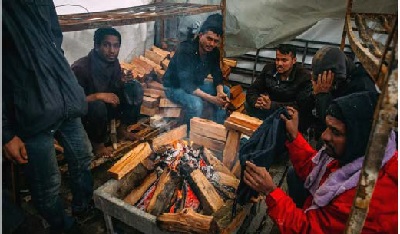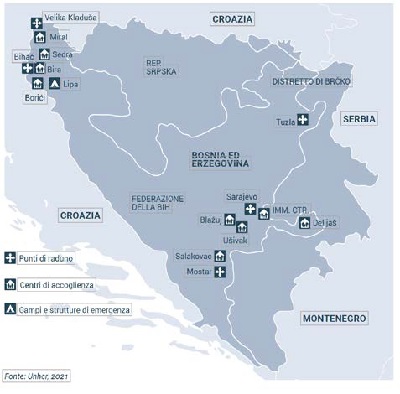At the edge of humanity
Publish date 16-03-2022
 Today it is the border between Poland and Belarus. Last year it was Lipa, a camp on fire on the border between Bosnia and Herzegovina and Croatia. And the years before were Horgos, on the border between Serbia and Hungary, or Sid, on the border between Serbia and Croatia, or even Idomeni, on the border between North Macedonia and Greece.
Today it is the border between Poland and Belarus. Last year it was Lipa, a camp on fire on the border between Bosnia and Herzegovina and Croatia. And the years before were Horgos, on the border between Serbia and Hungary, or Sid, on the border between Serbia and Croatia, or even Idomeni, on the border between North Macedonia and Greece.
For many (too many) years now, humanitarian emergencies have been regularly occurring in some corners of Europe along migratory routes, with consequent violations of human rights against people in transit, and with mass jeopardizing the life and health of those who are moving. Including many families, with women and young children. On balance: a real failure, if we think that Europe - and in particular the European Union - considers itself the cradle of rights, freedoms and peace.
The observation point where I am, Bosnia Herzegovina - where exactly one year ago (it was December 23, 2020) we witnessed the humanitarian crisis at the Lipa camp - allows you to see how it is the whole migratory phenomenon along the Balkan Route works.
Looking from one side - towards the East and towards the south - you can see the countries of origin of the migrants in transit: Afghanistan, Pakistan, Syria, Iraq, Palestine, those of North Africa, Somalia, Eritrea . Names of tormented places, often still at war, insecure, extremely vulnerable. Where the situation does not seem to improve with the passage of time, quite the opposite - let's just think about what happened this summer in Afghanistan.
 Looking from the other side - towards the West - we see the countries that migrants would like to reach: Italy, Austria, Germany, France, Poland, Northern Europe. Countries that, for a cruel historical paradox, joyfully remember the fall of the Berlin Wall, but at the same time today build other walls, those at their own borders. Countries so obsessed with "security" and "control" that they are willing to isolate themselves and close themselves more and more into a "fortress", in order not to allow anyone to enter their territory.
Looking from the other side - towards the West - we see the countries that migrants would like to reach: Italy, Austria, Germany, France, Poland, Northern Europe. Countries that, for a cruel historical paradox, joyfully remember the fall of the Berlin Wall, but at the same time today build other walls, those at their own borders. Countries so obsessed with "security" and "control" that they are willing to isolate themselves and close themselves more and more into a "fortress", in order not to allow anyone to enter their territory.
And - looking in the middle - we finally see the states of Eastern Europe,
mostly non-EU countries: Serbia, North Macedonia, Albania, Bosnia and Herzegovina, today also Belarus. Fragile countries, in which the transitions from communist regimes have not yet been completed, which struggle very much to solve their social, health and economic problems. And who today also find themselves having to deal with the challenge of these new migratory flows, without really knowing how to manage them.
Seen from here, therefore, this Route seems like a great game to lose, for everyone. In other words, it seems that no state and no community “gains” from this situation: neither the countries of origin, nor the countries of destination, nor whoever is in the middle. And neither do the migrants themselves, subjected to continuous violence, psychological trauma, deprivation. Only the mafias and traffickers gain from it, who get well paid for illegally crossing the various borders to those who migrate.
Being here along the Route it is therefore normal to ask: is it possible that this is the only way to manage the migratory phenomenon? Really in the Third Millennium are we not able to think and implement a different, more orderly, more "logical", more human system?
A light of hope along the Balkan Route, however, is kept alight by many experiences of solidarity and help from individual citizens, volunteers, associations. Looking closely, it turns out that there are many people who - perhaps in the silence of the media - every day bring a hug to those who migrate, offer a hot meal, give a word of comfort or a smile.
 Here in Bosnia and Herzegovina too there are dozens of volunteers and social workers (local and international) who have decided to dedicate their time, energy and skills along the Balkan Route. And hundreds of other people and organizations from Italy (Sermig, Caritas, many parishes and communities), in this past year since the Lipa crisis, wanted to show their attention and closeness to migrants in Bosnia and Herzegovina through generous donations.
Here in Bosnia and Herzegovina too there are dozens of volunteers and social workers (local and international) who have decided to dedicate their time, energy and skills along the Balkan Route. And hundreds of other people and organizations from Italy (Sermig, Caritas, many parishes and communities), in this past year since the Lipa crisis, wanted to show their attention and closeness to migrants in Bosnia and Herzegovina through generous donations.
Seen from the Route, those people are truly the best face of Europe. They are the faces of welcome and not of walls, of rights and not of violations, of hope and not of abandonment.
Daniele Bombardi
Regional coordinator in South East Europe, Caritas Italiana
NP December 2021







